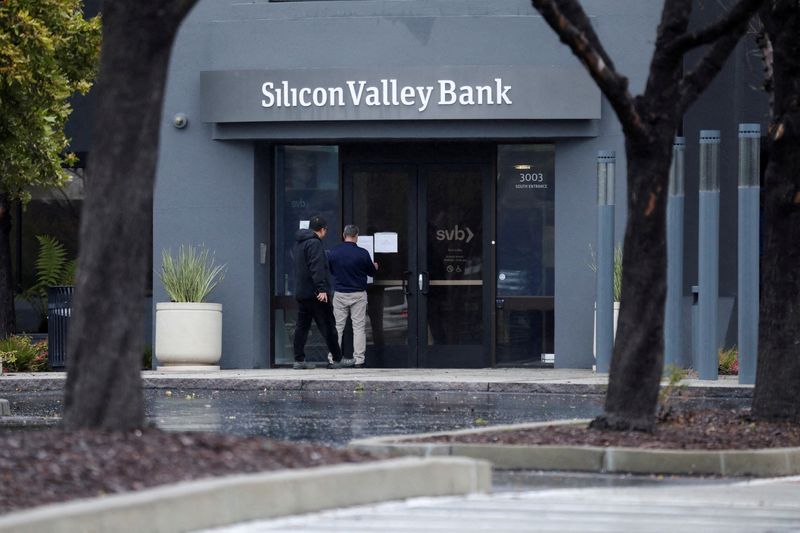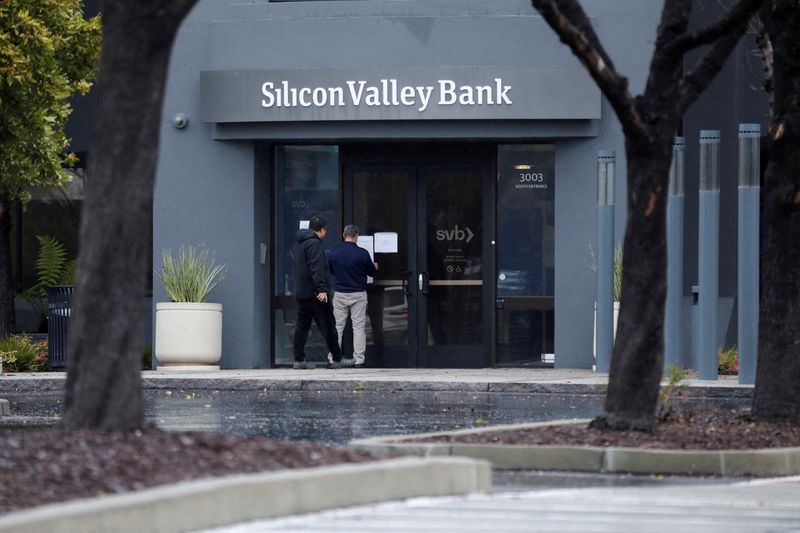Economy
US regulators clamp down in bid to prevent more bank failures


© Reuters. FILE PHOTO: A man puts a sign on the door of the Silicon Valley Bank as an onlooker watches at the bank?s headquarters in Santa Clara, California, U.S. March 10, 2023. REUTERS/Nathan Frandino/File Photo
2/2
By Pete Schroeder and Nupur Anand
WASHINGTON/NEW YORK (Reuters) – U.S. bank supervisors are increasing scrutiny of lenders’ risk management practices and taking disciplinary action as they try to fix problems that could lead to more bank failures, banking industry sources said.
The changes follow the collapse of Silicon Valley Bank, Signature Bank (OTC:) and First Republic Bank (OTC:) earlier this year after depositor runs sparked, in part, by worries that high interest rates would hurt bank balance sheets. After official reviews found frontline examiners failed to act quickly upon spotting problems, they are taking a tougher, more proactive approach.
Interviews with a dozen industry executives, lawyers and regulatory officials show examiners are executing surprise reviews of a key confidential supervisory bank health rating and in some cases have issued downgrades. They are increasingly warning big banks they will be placed under an order restricting a range of activities if they don’t fix lapses; and are pressing top executives to take personal accountability for addressing the banks’ problems.
While regulators including the Federal Reserve and the Federal Deposit Insurance Corporation (FDIC) have pledged to get tough on supervision, the process is confidential and officials have not released details. The activity, which Reuters is reporting for the first time, sheds light on how the agencies are making good on that promise, and suggests they continue to have concerns about some lenders’ health amid high interest rates and a slowing economy.
Supervisors are targeting small, mid-size and larger banks, the people said. Reuters could not ascertain exactly how many banks overall were targeted, but eight of the sources said they each had knowledge of multiple cases or banks affected.
“This is not unlike some of the more enhanced monitoring we saw during the Great Recession, where there was concern over all the banks’ financial health,” said John Geiringer, a Partner and banking attorney at Barack Ferrazzano Kirschbaum & Nagelberg LLP.
The FDIC and other regulators wrote in recent months to regional and community banks in a number of states notifying them they had launched surprise reviews of their “CAMELS” rating, five of the people said. The confidential rating measures bank safety and soundness on metrics including capital adequacy, asset quality, management competence and liquidity.
Examiners typically review small banks’ ratings every 12 to 18 months via an analysis of financial and loan data banks report quarterly, onsite exams, and discussions with executives.
Anne Balcer, a senior executive vice president at the Independent Community Bankers (NASDAQ:) of America (ICBA), said members of the Washington trade group in different regions had received letters around October notifying them of the off-cycle reviews.
In some cases, banks were advised components of their CAMELS rating had been downgraded. The reviews were based on regulators’ analysis of the quarterly data, she and three other people with knowledge of several other cases said.
The implications “are pretty far reaching,” said Balcer. CAMELS ratings contribute to banks’ deposit insurance premiums and affect their audits. Downgraded lenders can be barred from doing deals, and could be denied emergency Fed liquidity.
Reasons regulators cited for downgrades included insufficient capital, management issues, and in many cases, exposure to commercial real estate, a sector struggling amid high rates and lingering office vacancies, the people said.
The ICBA, which represent banks with up to $50 billion in assets, declined to name the banks concerned.
“Off-cycle downgrades are a touchy thing,” said Michael Tierney, CEO of the Community Bankers of Michigan, who said he had been briefed on some off-cycle reviews. “What I’ve been told by regulators is that this will be used sparingly, they will only downgrade CAMEL components, not the overall CAMELs rating.”
In those conversations, officials said they are looking much harder at liquidity and interest rate risk management. “They’ve been very clear…those are their top priorities,” said Tierney.
‘PAINFUL’
A spokesperson for the FDIC said the agency has long used off-site monitoring to supplement and guide examinations, and has developed tools using quarterly data reports to do so.
“Off-site monitoring programs can provide an early indication that an institution’s risk profile may be changing,” he said.
“CAMELS ratings, including those that are changed on an interim basis are confidential, but as a general matter, ratings trends tend to deteriorate as macroeconomic conditions worsen,” he continued, citing inflation and high rates as key headwinds.
Two small banks have failed since First Republic, and the FDIC recently added another to its list of problem banks. Many lenders are holding onto piles of cash as insurance against a slowing economy, Reuters has reported.
Spokespeople for the Fed and Office of the Comptroller of the Currency, another federal regulator, declined to comment.
Bigger banks are monitored continuously but they are still feeling increased pressure, said five other sources that work with multiple big lenders. Their supervisors are more frequently warning top management that failing to fix problems could result in a confidential “4(m)” sanction, the people said.
Supervisors typically impose a 4(m) for weak capital, poor management, or following a CAMELS downgrade. Banks under a 4(m) must get regulatory approval to engage in some new business, such as securities underwriting, or to make nonbank investments.
Exiting a 4(m) can take years. It can involve hiring new people and reorganizing businesses. “It’s really painful,” said one source who asked not to be identified discussing confidential supervisory issues.
Supervisors are also pressing big bank bosses to take more personal accountability for problems, in some cases seeking briefings with C-suite executives or board members to secure assurances that they are personally on top of the problems, two of the people said.
They said this had raised concerns for some senior executives worried about personal liability.
“As risks increase, supervisors are going to react appropriately,” said Karen Lawson, executive vice president for policy and supervision at the Conference of State Bank Supervisors, the national organization representing state regulators, which supervise 79% of U.S. banks alongside federal agencies.
State regulators are discussing ways to be more responsive, including by moving independently to quickly address problems without waiting for a consensus with federal regulators, she said.
“Certainly, we all learned things earlier this year.”
Economy
Russian central bank says it needs months to make sure CPI falling before rate cuts -RBC


© Reuters. Russian Central Bank Governor Elvira Nabiullina attends a news conference in Moscow, Russia June 14, 2019. REUTERS/Shamil Zhumatov/File Photo
MOSCOW (Reuters) – Russia’s central bank will need two to three months to make sure that inflation is steadily declining before taking any decision on interest rate cuts, the bank’s governor Elvira Nabiullina told RBC media on Sunday.
The central bank raised its key interest rate by 100 basis points to 16% earlier in December, hiking for the fifth consecutive meeting in response to stubborn inflation, and suggested that its tightening cycle was nearly over.
Nabiullina said it was not yet clear when exactly the regulator would start cutting rates, however.
“We really need to make sure that inflation is steadily decreasing, that these are not one-off factors that can affect the rate of price growth in a particular month,” she said.
Nabiullina said the bank was taking into account a wide range of indicators but primarily those that “characterize the stability of inflation”.
“This will take two or three months or more – it depends on how much the wide range of indicators that characterize sustainable inflation declines,” she said.
The bank will next convene to set its benchmark rate on Feb. 16.
The governor also said the bank should have started monetary policy tightening earlier than in July, when it embarked on the rate-hiking cycle.
Economy
China identifies second set of projects in $140 billion spending plan


© Reuters. FILE PHOTO: Workers walk past an under-construction area with completed office towers in the background, in Shenzhen’s Qianhai new district, Guangdong province, China August 25, 2023. REUTERS/David Kirton/File Photo
SHANGHAI (Reuters) – China’s top planning body said on Saturday it had identified a second batch of public investment projects, including flood control and disaster relief programmes, under a bond issuance and investment plan announced in October to boost the economy.
With the latest tranche, China has now earmarked more than 800 billion yuan of its 1 trillion yuan ($140 billion) in additional government bond issuance in the fourth quarter, as it focuses on fiscal steps to shore up the flagging economy.
The National Development and Reform Commission (NDRC) said in a statement on Saturday it had identified 9,600 projects with planned investment of more than 560 billion yuan.
China’s economy, the world’s second largest, is struggling to regain its footing post-COVID-19 as policymakers grapple with tepid consumer demand, weak exports, falling foreign investment and a deepening real estate crisis.
The 1 trillion yuan in additional bond issuance will widen China’s 2023 budget deficit ratio to around 3.8 percent from 3 percent, the state-run Xinhua news agency has said.
“Construction of the projects will improve China’s flood control system, emergency response mechanism and disaster relief capabilities, and better protect people’s lives and property, so it is very significant,” the NDRC said.
The agency said it will coordinate with other government bodies to make sure that funds are allocated speedily for investment and that high standards of quality are maintained in project construction.
($1 = 7.1315 renminbi)
Economy
Russian central bank says it needs months to make sure CPI falling before rate cuts -RBC


© Reuters. Russian Central Bank Governor Elvira Nabiullina attends a news conference in Moscow, Russia June 14, 2019. REUTERS/Shamil Zhumatov/File Photo
MOSCOW (Reuters) – Russia’s central bank will need two to three months to make sure that inflation is steadily declining before taking any decision on interest rate cuts, the bank’s governor Elvira Nabiullina told RBC media on Sunday.
The central bank raised its key interest rate by 100 basis points to 16% earlier in December, hiking for the fifth consecutive meeting in response to stubborn inflation, and suggested that its tightening cycle was nearly over.
Nabiullina said it was not yet clear when exactly the regulator would start cutting rates, however.
“We really need to make sure that inflation is steadily decreasing, that these are not one-off factors that can affect the rate of price growth in a particular month,” she said.
Nabiullina said the bank was taking into account a wide range of indicators but primarily those that “characterize the stability of inflation”.
“This will take two or three months or more – it depends on how much the wide range of indicators that characterize sustainable inflation declines,” she said.
The bank will next convene to set its benchmark rate on Feb. 16.
The governor also said the bank should have started monetary policy tightening earlier than in July, when it embarked on the rate-hiking cycle.

 Forex3 years ago
Forex3 years agoForex Today: the dollar is gaining strength amid gloomy sentiment at the start of the Fed’s week

 Forex3 years ago
Forex3 years agoUnbiased review of Pocket Option broker

 Forex3 years ago
Forex3 years agoDollar to pound sterling exchange rate today: Pound plummeted to its lowest since 1985

 Forex3 years ago
Forex3 years agoHow is the Australian dollar doing today?

 Cryptocurrency3 years ago
Cryptocurrency3 years agoWhat happened in the crypto market – current events today

 World3 years ago
World3 years agoWhy are modern video games an art form?

 Commodities3 years ago
Commodities3 years agoCopper continues to fall in price on expectations of lower demand in China

 Economy3 years ago
Economy3 years agoCrude oil tankers double in price due to EU anti-Russian sanctions

























